
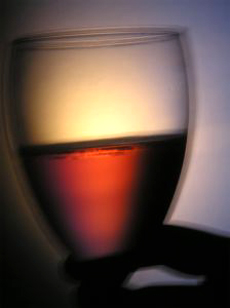 If you don’t drink Beaujolais in the cooler months because you’re too tied into Cab and Pinot, try it as your summer red. Photo by Saïvann | Sxc.
If you don’t drink Beaujolais in the cooler months because you’re too tied into Cab and Pinot, try it as your summer red. Photo by Saïvann | Sxc.
|
R. VERONIQUE FITZGERALD is wine consultant and writer in New York City.
|
|
June 2007 |
 |
Product Reviews / Main Nibbles / Wine
Choice Red Wines For Summer
There’s No Law That Says Summer Wine Is White Wine: You Can Chill & Sip These Reds All Summer Long
CAPSULE REPORT: If you aren’t fond of white wines, you may not welcome the warmer months, when white wine rules. But wine writer Veronique Fitzgerald clues us in to summer reds that provide an alternative—even to white wine fans who’d like something different with that steak on the grill. Yes, you can chill [some] red wine!
As the days get hotter, my good friend Darlene comes to mind. She’s a lovely, sophisticated woman who does not like white wine. Conventional wisdom forbids us from enjoying a glass of chilled red wine. Ever. Admittedly, there is some truth to this: Many red wines, especially very tannic ones, really are better served at cellar temperature and warmer, up to about 75°F, because the tannin tastes more astringent in wines served at lower temperatures.
But must Darlene drink her red wine warm, even in the summer? Is there no good red wine she could put in the refrigerator to enjoy on her back patio in the heat of the day? The red wines below do indeed like a bit of fridge time to chill for people like Darlene, who still want to enjoy red wine on balmy late spring and summer days.
Dark Rosés*
A Memorial Day tasting with Darlene, her husband Bobby and my husband Shehu actually started with Vinavera Dry Rosé Napa Valley 2005 ($14.00, screwtop), a rosé of Syrah and Grenache that is dark enough in color to almost qualify as red. She loved this wine, which was served well chilled, especially with Cheddar cheese (Darlene served both white and sharp kinds with crackers). There are other very red rosés out there—darker rosés tend to feel richer in the mouth because they have more tannin than the paler rosés.
- Darlene might also have enjoyed Cantina Cantalupo’s Il Mimo Rosato 2006
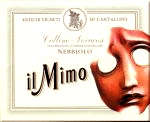 ($12.00), a Nebbiolo rosé from Piedmont that is easy to spot if you look for the mask of the mime (il mimo) on the label. While Vinavera seems to be easier to find on the west coast, particularly in California and Oregon, Il Mimo can be found in several New York and New Jersey stores. Most stores will have at least one dark rosé on their racks for summer. ($12.00), a Nebbiolo rosé from Piedmont that is easy to spot if you look for the mask of the mime (il mimo) on the label. While Vinavera seems to be easier to find on the west coast, particularly in California and Oregon, Il Mimo can be found in several New York and New Jersey stores. Most stores will have at least one dark rosé on their racks for summer.
Rosé wines are almost always made from red grapes, in a process known as saigner (sane-YAY), or bleeding. Red wines are made red because the skins are left to steep in the juice of the crushed grapes to impart their color; the skins are removed from the juice earlier to create rosé. The longer the skins are left in, the darker the resulting wine, and consequently, the more tannin the wine will have, as tannin also comes from the skin. The exception to this rule is with Champagne, where rosé Champagne is made from a blend of red and white wines.
Beaujolais
Technically a part of Burgundy, Beaujolais is regarded as a separate region. When asked to name the two red grapes of Burgundy, most people wouldn’t be able to get past the revered Pinot Noir; but Gamay, the grape of Beaujolais, rules the southern 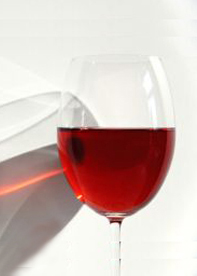 climes of the Burgundy region. Most of us associate Beaujolais with George DuBoeuf’s Beaujolais Nouveau, the wine of the new vintage that is released on the third Thursday of every November to much fabricated fanfare (Beaujolais Nouveau, a young, simple wine, was invented by DuBoeuf as a marketing gimmick to get cash flow while the “real Beaujolais” aged for months in casks). Nouveau is the essence of a great summer sipper, made by a method called carbonic maceration,* which produces a wine of moderate acidity, low tannin, simple, overt fruitiness, even with a bit of spritz. Sadly, since Nouveau is meant to be consumed by the end of December, one would be hard pressed to find a bottle in late spring, and if one did, it would likely be over the hill. Fortunately, there is other Beaujolais to be had. climes of the Burgundy region. Most of us associate Beaujolais with George DuBoeuf’s Beaujolais Nouveau, the wine of the new vintage that is released on the third Thursday of every November to much fabricated fanfare (Beaujolais Nouveau, a young, simple wine, was invented by DuBoeuf as a marketing gimmick to get cash flow while the “real Beaujolais” aged for months in casks). Nouveau is the essence of a great summer sipper, made by a method called carbonic maceration,* which produces a wine of moderate acidity, low tannin, simple, overt fruitiness, even with a bit of spritz. Sadly, since Nouveau is meant to be consumed by the end of December, one would be hard pressed to find a bottle in late spring, and if one did, it would likely be over the hill. Fortunately, there is other Beaujolais to be had.
Photo by Quentin Houyoux | Sxc.
*In carbonic maceration, bunches of grapes are piled into large fermenters in which carbon dioxide supplants oxygen in the atmosphere to create anaerobic conditions. As The Oxford Companion to Wine, Third Edition (Robinson, 2006) describes it, “an intracellular fermentation takes place within the intact berry and a small amount of ethanol is formed, along with traces of many flavorful aromatic compounds.” Vintners take anywhere from one to three weeks to carry out this process. In practice, the weight of the grapes on top begins to crush some of the fruit below, so traditional fermentation (yeast eating sugar to produce alcohol) by yeasts that live on the skins of wine grapes and in the winemaking environment inevitably ensues. Later, the grapes are crushed on purpose to enable fermentation. The resulting wine is very bright in color and usually has a bit of spritz to it because of the carbon dioxide it absorbs in the process. It often has distinct aromas of bananas and kirsch, among other fruits. The whole procedure happens quite rapidly, and the resulting wines are not suitable for aging. Grapes picked in late September are quickly made into wine that arrives in the U.S. by Thanksgiving of the same year!
Beaujolais Villages
Enter Beaujolais Villages (pronounced vill-AHJ). It is made from Gamay grapes picked  region-wide, just as Nouveau, but it is vinified in the usual manner of red wine (grapes are crushed and pressed, then the juice with is fermented). Villages usually has a little more body than Nouveau with crisp acidity and a minimal helping of tannin. lends itself well to chilling. region-wide, just as Nouveau, but it is vinified in the usual manner of red wine (grapes are crushed and pressed, then the juice with is fermented). Villages usually has a little more body than Nouveau with crisp acidity and a minimal helping of tannin. lends itself well to chilling.
- DuBoeuf’s Beaujolais Villages ($8.00 to $10.00 a bottle, single serve 187 ml bottles under $2.00, half bottles around $4.00), is a very light, fruity version that is not a far cry from Nouveau. Many stores around the country still have 2004 and 2005 vintages of this wine. Young is best, so buy the most recent vintage you can find. You will see the 2006 in more and more stores in the coming months.
- Louis Jadot, an old and well respected Burgundy grower-negotiant whose beige label most of us would recognize, offers Louis Jadot Beaujolais Villages from the hot 2005 vintage ($10.00, $5.00 to $7.00 a half bottle) that is surprisingly more complex and interesting than DuBoeuf’s, if a little less fruity, especially out of the fridge. The Villages spent a night in the fridge and sat out for 30 minutes before tasting, which took place on an 85F day. They were both rather refreshing!
Cru Beaujolais
And then there are Cru Beaujolais. The word “cru” in viticultural French means growth or crop, and suggests a scale or ranking that identifies vineyards that have consistently yielded grapes of high quality over the years (as in Premier Cru, or First Growth in Bordeaux). In the Beaujolais region, ten villages that follow a straight line from north to south qualify as cru villages. They are recognized for their unique soils and growing conditions; each cru wine is different from the next. From north to south, the cru villages are St. Amour, Juliénas, Chénas, Moulin-à-Vent, Fleurie, Chiroubles, Morgon, Regnié, Brouilly and Côtes de Brouilly. For example, the wines of Morgon, especially those from the Côte de Py vineyard, are substantial wines with enough tannin, alcohol and earthiness to rival Côte d’Or Pinot Noir wines from further north.
- Louis Jadot’s Château des Lumières Morgon 2003, which retails at around $40.00 a bottle in New York and New Jersey (a bit overpriced; the 2004 is available in one Pennsauken, NJ store for $16.99), had a deep purple hue, with ripe grape and cherry fruit laced with cedar and licorice on the nose and an intriguing mix of pink grapefruit, bubblegum, mushrooms and earthiness on a complex palate. These nuances would likely be muted if the wine were too cold. With 13% alcohol and a healthy dose of tannin, cellar temperature (around 58F) is cool enough for this wine. The cru villages of Chénas, Juliénas and Moulin-à-Vent are known for similarly impressive wines.
- On the other hand, Brouilly is the largest cru (a totally different village from Côtes
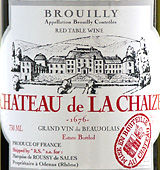 de Brouilly), and Château de la Chaize Brouilly 2005 (around $13.00 and available in most states, though one Rhode Island store has it for $16.00) was adequately villages-like to be a fun alternative to the other red summer sippers. It had nice strawberry and raspberry fruitiness, with fresh, citric acidity and modest tannin and alcohol levels. This was the second wine in Darlene’s tasting. She didn’t care for it much, finding it tart and heavy after the light, crisp rosé. Bobby loved it! He really enjoyed the fruity character and the finish. de Brouilly), and Château de la Chaize Brouilly 2005 (around $13.00 and available in most states, though one Rhode Island store has it for $16.00) was adequately villages-like to be a fun alternative to the other red summer sippers. It had nice strawberry and raspberry fruitiness, with fresh, citric acidity and modest tannin and alcohol levels. This was the second wine in Darlene’s tasting. She didn’t care for it much, finding it tart and heavy after the light, crisp rosé. Bobby loved it! He really enjoyed the fruity character and the finish.
Dolcetto
The little sweet one is a native to the provinces of Cuneo and Alessandria in the 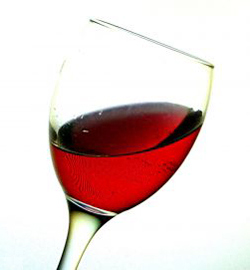 Piedmont region of Italy. Dolcetto’s wines are light and fruity, often with a licorice nuance, and made to be drunk within 2 to 3 years. The New Wine Lover’s Companion (Herbst and Herbst, 2003) lists seven DOCs, or appellations in Piedmont to which the grape lends its name: Dolcetto d’Acqui, Dolcetto d’Asti, Dolcetto di Diano d’Alba, Dolcetto delle Langhe Monregalesi, Dolcetto di Dogliani, Dolcetto di Ovada and Dolcetto d’Alba. Piedmont region of Italy. Dolcetto’s wines are light and fruity, often with a licorice nuance, and made to be drunk within 2 to 3 years. The New Wine Lover’s Companion (Herbst and Herbst, 2003) lists seven DOCs, or appellations in Piedmont to which the grape lends its name: Dolcetto d’Acqui, Dolcetto d’Asti, Dolcetto di Diano d’Alba, Dolcetto delle Langhe Monregalesi, Dolcetto di Dogliani, Dolcetto di Ovada and Dolcetto d’Alba.
Photo by Jocilyn Pope | Sxc.
There are many small producers of Dolcetto between $9.00 and $14.00 a bottle available in retail outlets nationwide, invariably made by vintners who also make wines from the Barbera and Nebbiolo varieties. Put yourself in the hands of your most trusted retailer to help you pick a great Dolcetto to open at your next summer barbecue.
- Bartolo Mascarello, whose legendary Barolos and Barbarescos retail for upwards of one hundred dollars a bottle, markets Bartolo Mascarello Dolcetto d’Alba 2005 for $25.99. Mascarello’s 2003 Dolcetto is still in the market, but think twice about buying it unless it has been kept in storage at a constant cellar temperature away from bright light, and lying on its side so as to keep the cork moist.
- Everyone at the Memorial Day tasting enjoyed E. Pira & Figli Dolcetto d’Alba 2005 ($18.99), particularly when they tried it with the sharp Cheddar. Shehu thought it might also taste nice with a funky Brie and some sourdough bread. Because it was so hot over Memorial Day weekend, this Dolcetto spent two hours chilling in the fridge before our tasting, against the advice of the retailer who sold it to me. As a result, the wine was cool and juicy to drink, with a characteristic fruity, anise-laced profile.
Good Dolcetto should be youthful, though not necessarily young. Wines of Dolcetto di Ovada and Dolcetto d’Alba have been known to age up to 5 years.
Brachetto d’Acqui
This is not your mom’s Lambrusco. From the town of Acqui in the Piedmont area of Italy, this is another red bubbly made from the aromatic Brachetto grape, which is grown around the Piemontese provinces of Asti, Roero and Alessandria. It is usually paler in color, though still sufficiently red to stay out of the rosé category, and comes in both spumante (as bubbly as Champagne) or frizzante (less bubbly, like Moscato d’Asti) styles. Although dry versions have been known, these days they’re usually off-dry to semi-sweet with the distinct aroma and flavor of strawberries.
- Banfi’s Rosa Regale ($20.00, half bottles are $10.00) is by far the most ubiquitous brand, and it is very tasty. Rosa Regale is a spumante in a sexy bottle adorned with a rose.
- Ca’ dei Mandorli markets a great frizzante style (around $20.00, though one Miami Beach shop has the 2004 for $15.00), as does Coppo, and both are bottled like still wines.
- You can use a corkscrew to remove the composite cork from the neck of a bottle of Coppo’s Passione Brachetto d’Acqui DOCG 2006 to the sound of a tame
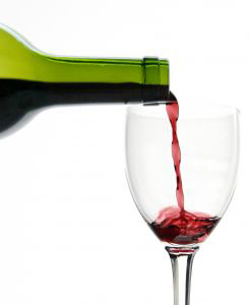 pop, followed by a breath of carbon dioxide. Though stores in many states carry whites and reds from Coppo that range from $12.00 half bottles of Moscato d’Asti to a $23.00 Barbera d’Asti, very few (I only found one, at www.winerz.com, an online wine shop based in Orange County, CA) are brave enough to offer this $26.00 Brachetto. Try asking for the brand, then ask for the Brachetto. A good retailer might special order some for you if you ask nicely. Passione is ruby red with purple hints and large bubbles. The nose and palate are full of cola, grape-ade and those midsummer strawberries that are a common varietal characteristic. Serve this wine well chilled to temper the sweetness. If you like, even (dare I say it?) a cube of ice dropped in might enhance this wine. Drunk from a champagne flute on a warm evening, it was lovely with macaroni and cheese and spicy spare ribs off the grill. pop, followed by a breath of carbon dioxide. Though stores in many states carry whites and reds from Coppo that range from $12.00 half bottles of Moscato d’Asti to a $23.00 Barbera d’Asti, very few (I only found one, at www.winerz.com, an online wine shop based in Orange County, CA) are brave enough to offer this $26.00 Brachetto. Try asking for the brand, then ask for the Brachetto. A good retailer might special order some for you if you ask nicely. Passione is ruby red with purple hints and large bubbles. The nose and palate are full of cola, grape-ade and those midsummer strawberries that are a common varietal characteristic. Serve this wine well chilled to temper the sweetness. If you like, even (dare I say it?) a cube of ice dropped in might enhance this wine. Drunk from a champagne flute on a warm evening, it was lovely with macaroni and cheese and spicy spare ribs off the grill.
Photo by Carlos Zaragoza | Sxc.
- In the Memorial Day tasting, Marenco’s Pineto Brachetto D’Acqui 2006 ($18.99, though one Los Angeles retailer lists it for $14.99), also frizzante, was the hands down favorite of the day.
The thing to remember is that many of the unwritten “rules” of wine drinking are born of tradition. In reality, the only rule is that you must enjoy what you’re drinking. Just as there are those who scoff at the practice of chilling red wine, there are those who think room temperature is far to warm to serve any wine at all. There are still others who like a well-chilled Sauvignon Blanc, but prefer an oaky Chardonnay close to room temperature. With a little experimentation, you can discover how best to drink and serve your favorite wines, and those will be the rules in your house. Better still, have your cool glass of red wine with a grilled chicken breast and a fresh salad. That’ll give them something to talk about!
Lifestyle Direct, Inc. All rights reserved. Images are the copyright of their respective owners.

|



 ($12.00), a Nebbiolo rosé from Piedmont that is easy to spot if you look for the mask of the mime (il mimo) on the label. While Vinavera seems to be easier to find on the west coast, particularly in California and Oregon, Il Mimo can be found in several New York and New Jersey stores. Most stores will have at least one dark rosé on their racks for summer.
($12.00), a Nebbiolo rosé from Piedmont that is easy to spot if you look for the mask of the mime (il mimo) on the label. While Vinavera seems to be easier to find on the west coast, particularly in California and Oregon, Il Mimo can be found in several New York and New Jersey stores. Most stores will have at least one dark rosé on their racks for summer.  climes of the Burgundy region. Most of us associate Beaujolais with George DuBoeuf’s Beaujolais Nouveau, the wine of the new vintage that is released on the third Thursday of every November to much fabricated fanfare (Beaujolais Nouveau, a young, simple wine, was invented by DuBoeuf as a marketing gimmick to get cash flow while the “real Beaujolais” aged for months in casks). Nouveau is the essence of a great summer sipper, made by a method called carbonic maceration,* which produces a wine of moderate acidity, low tannin, simple, overt fruitiness, even with a bit of spritz. Sadly, since Nouveau is meant to be consumed by the end of December, one would be hard pressed to find a bottle in late spring, and if one did, it would likely be over the hill. Fortunately, there is other Beaujolais to be had.
climes of the Burgundy region. Most of us associate Beaujolais with George DuBoeuf’s Beaujolais Nouveau, the wine of the new vintage that is released on the third Thursday of every November to much fabricated fanfare (Beaujolais Nouveau, a young, simple wine, was invented by DuBoeuf as a marketing gimmick to get cash flow while the “real Beaujolais” aged for months in casks). Nouveau is the essence of a great summer sipper, made by a method called carbonic maceration,* which produces a wine of moderate acidity, low tannin, simple, overt fruitiness, even with a bit of spritz. Sadly, since Nouveau is meant to be consumed by the end of December, one would be hard pressed to find a bottle in late spring, and if one did, it would likely be over the hill. Fortunately, there is other Beaujolais to be had.  region-wide, just as Nouveau, but it is vinified in the usual manner of red wine (grapes are crushed and pressed, then the juice with is fermented). Villages usually has a little more body than Nouveau with crisp acidity and a minimal helping of tannin. lends itself well to chilling.
region-wide, just as Nouveau, but it is vinified in the usual manner of red wine (grapes are crushed and pressed, then the juice with is fermented). Villages usually has a little more body than Nouveau with crisp acidity and a minimal helping of tannin. lends itself well to chilling. de Brouilly), and Château de la Chaize Brouilly 2005 (around $13.00 and available in most states, though one Rhode Island store has it for $16.00) was adequately villages-like to be a fun alternative to the other red summer sippers. It had nice strawberry and raspberry fruitiness, with fresh, citric acidity and modest tannin and alcohol levels. This was the second wine in Darlene’s tasting. She didn’t care for it much, finding it tart and heavy after the light, crisp rosé. Bobby loved it! He really enjoyed the fruity character and the finish.
de Brouilly), and Château de la Chaize Brouilly 2005 (around $13.00 and available in most states, though one Rhode Island store has it for $16.00) was adequately villages-like to be a fun alternative to the other red summer sippers. It had nice strawberry and raspberry fruitiness, with fresh, citric acidity and modest tannin and alcohol levels. This was the second wine in Darlene’s tasting. She didn’t care for it much, finding it tart and heavy after the light, crisp rosé. Bobby loved it! He really enjoyed the fruity character and the finish.  Piedmont region of Italy. Dolcetto’s wines are light and fruity, often with a licorice nuance, and made to be drunk within 2 to 3 years.
Piedmont region of Italy. Dolcetto’s wines are light and fruity, often with a licorice nuance, and made to be drunk within 2 to 3 years.  pop, followed by a breath of carbon dioxide. Though stores in many states carry whites and reds from Coppo that range from $12.00 half bottles of Moscato d’Asti to a $23.00 Barbera d’Asti, very few (I only found one, at www.winerz.com, an online wine shop based in Orange County, CA) are brave enough to offer this $26.00 Brachetto. Try asking for the brand, then ask for the Brachetto. A good retailer might special order some for you if you ask nicely. Passione is ruby red with purple hints and large bubbles. The nose and palate are full of cola, grape-ade and those midsummer strawberries that are a common varietal characteristic. Serve this wine well chilled to temper the sweetness. If you like, even (dare I say it?) a cube of ice dropped in might enhance this wine. Drunk from a champagne flute on a warm evening, it was lovely with macaroni and cheese and spicy spare ribs off the grill.
pop, followed by a breath of carbon dioxide. Though stores in many states carry whites and reds from Coppo that range from $12.00 half bottles of Moscato d’Asti to a $23.00 Barbera d’Asti, very few (I only found one, at www.winerz.com, an online wine shop based in Orange County, CA) are brave enough to offer this $26.00 Brachetto. Try asking for the brand, then ask for the Brachetto. A good retailer might special order some for you if you ask nicely. Passione is ruby red with purple hints and large bubbles. The nose and palate are full of cola, grape-ade and those midsummer strawberries that are a common varietal characteristic. Serve this wine well chilled to temper the sweetness. If you like, even (dare I say it?) a cube of ice dropped in might enhance this wine. Drunk from a champagne flute on a warm evening, it was lovely with macaroni and cheese and spicy spare ribs off the grill.